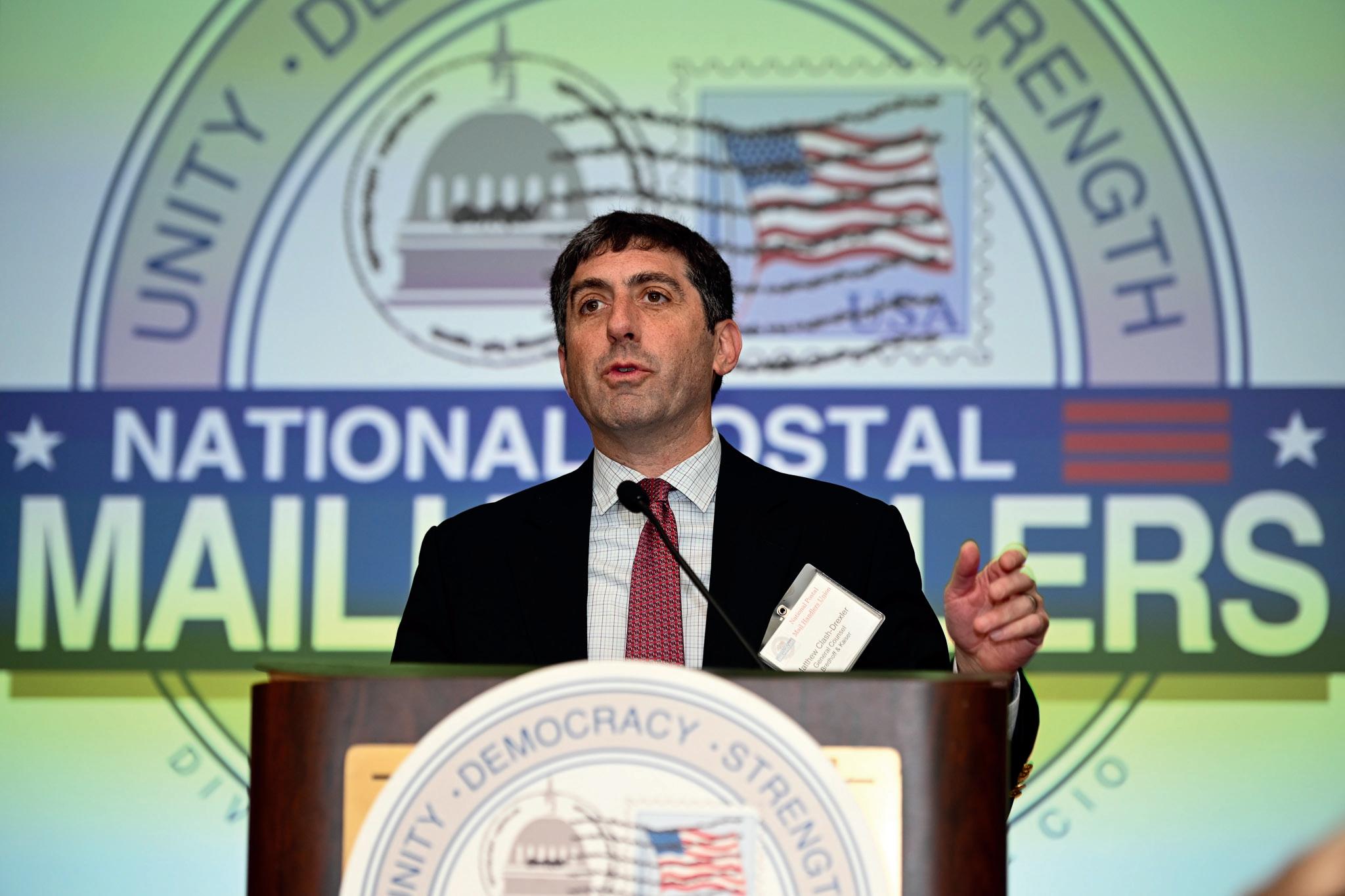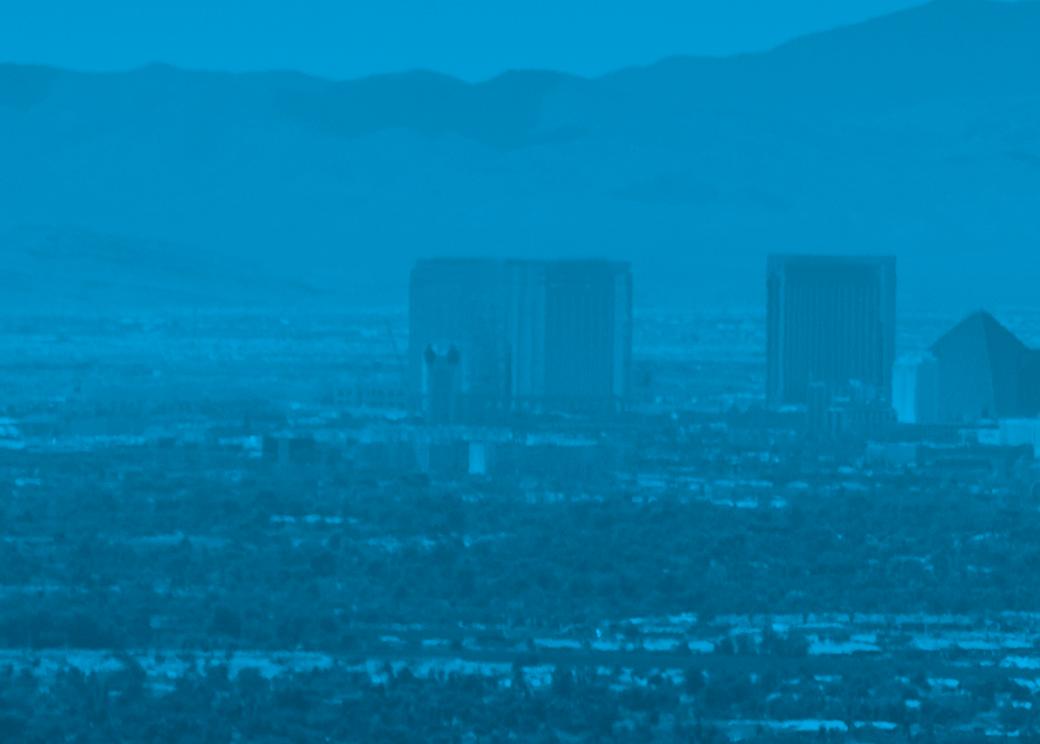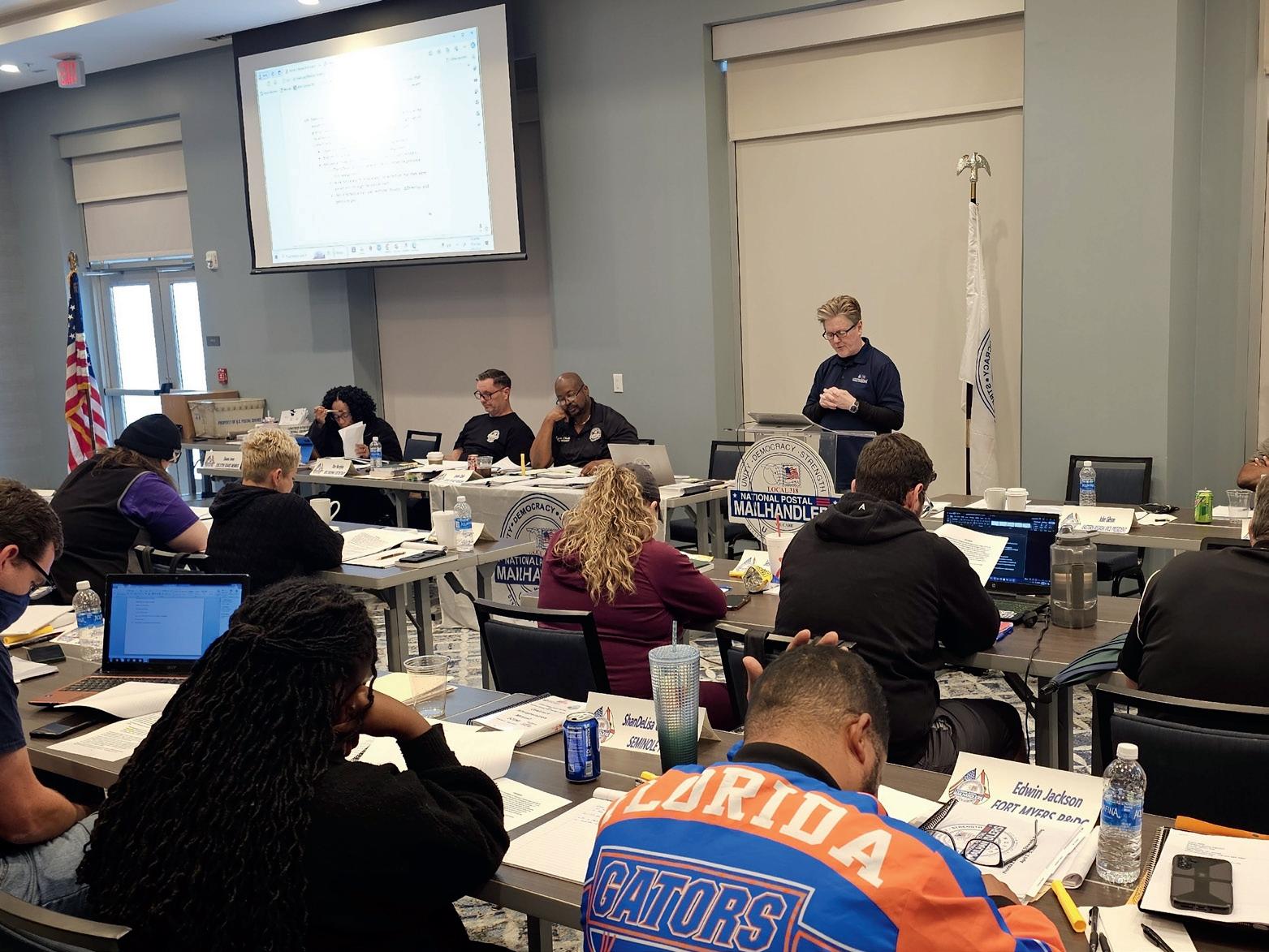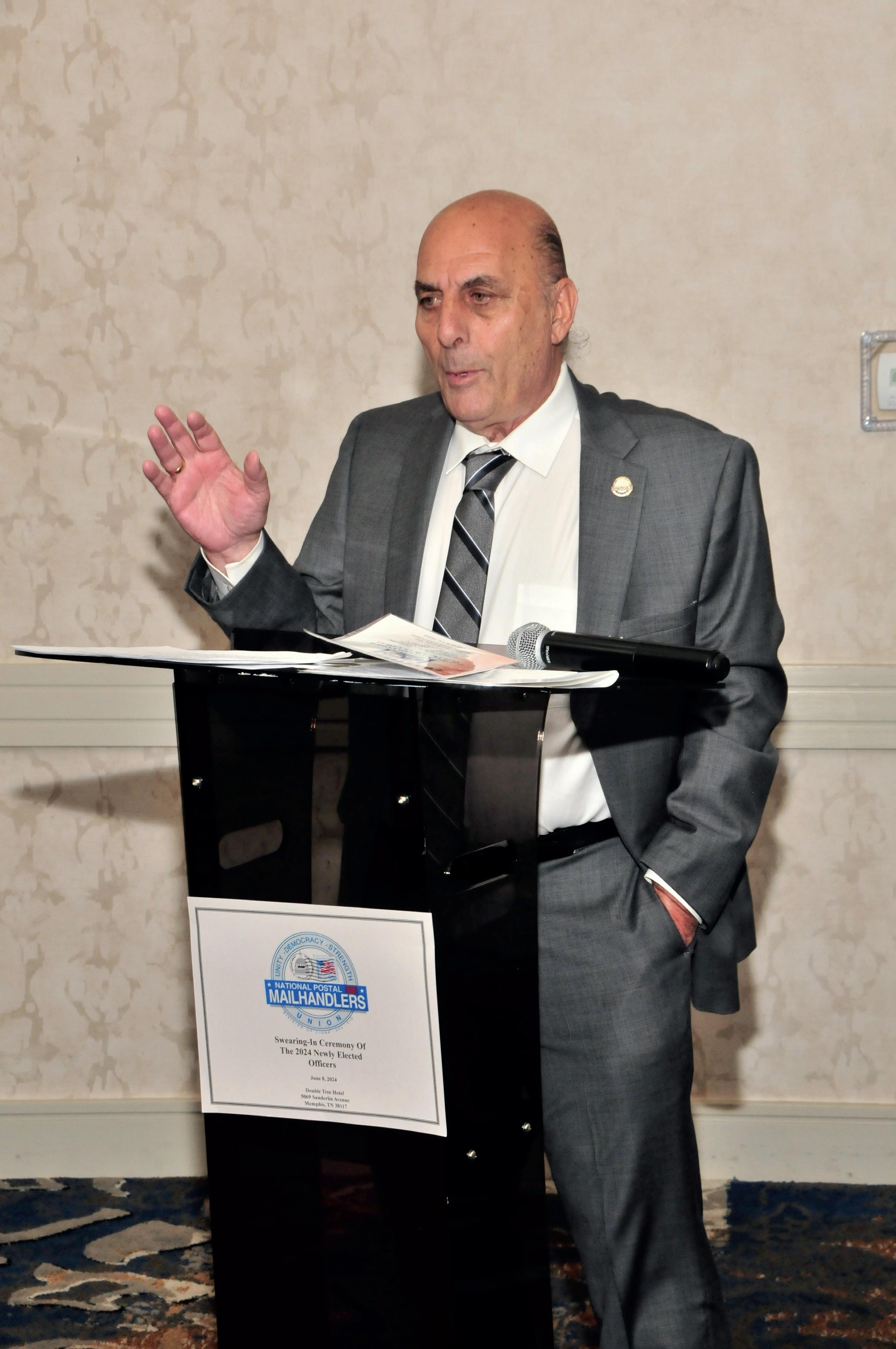


























































































































































Go to the App Store or Google Play and search “NPMHU” to install and use at no charge




























































































FOR YOUR IPHONE OR ANDROID SMARTPHONE



















































We are pleased to provide this communication tool to all Mail Handlers. You can access the latest news, updates, events, and information of organizational importance. THE APP’S FEATURES INCLUDE:



















+ Current NPMHU news with periodic push notifications of importance






+ Legislative and Political NPMHU Action Center


















+ Quadrennial Convention Information
+ NPMHU Women’s Committee










+ Current Wage Charts






























NATIONAL
Paul V. Hogrogian
National President
Kevin P. Tabarus
Secretary-Treasurer
June Harris
Vice President Central Region
John A. Gibson
Vice President Eastern Region
David E. Wilkin
Vice President Northeastern Region
Lawrence B. Sapp
Vice President Southern Region
Don J. Sneesby
Vice President Western Region
The Mail Handler, ISSN:1098-5689, is published quarterly by the National Postal Mail Handlers Union, 815 16th St, N.W. Suite 5100, Washington, DC 20006. Periodicals postage paid at Washington, D.C. and additional mailing offices.
POSTMASTER: Send address changes to The Mail Handler, 815 16th St, N.W. Suite 5100, Washington, DC 20006. Copyright 2024: National Postal Mail Handlers Union. All rights reserved. Reproduction without permission is prohibited. The Mail Handler is published for the members of our union. For additional copies please send $2.00 to: National Postal Mail Handlers Union—National Headquarters, 815 16th St, N.W. Suite 5100, Washington, DC 20006, (202) 833-9095.








Paul V. Hogrogian, National President
Dear Members:
The Postal Service continues to aggressively roll out and implement its new, more comprehensive Network Redesign plan. The centerpiece of the Network Redesign project is the establishment of Regional Processing and Distribution Centers (RPDCs) in approximately 60 metropolitan areas throughout the country. These RPDCs will consolidate all originating letters, flats, and parcels and all destinating parcels from all mail processing facilities within a metropolitan area into one mega-processing center. Most of the processing plants from which originating mail will be taken would continue to process destinating letters and flats and would be renamed Local Processing Centers (LPCs).
The USPS has announced that the initial RPDC sites are (all subject to change):
1. Sandston (Richmond), VA
2. North Houston, TX
3. Atlanta, GA
4. Charlotte, NC
5. Chicago, IL
6. Santa Clarita, CA
7. Indianapolis, IN
8. Portland, OR
9. Jacksonville, FL
10. Boise, ID
11. Oklahoma City, OK
12. Phoenix, AZ
13. Royal Palm, FL
14. Greensboro, NC
The Postal Service has notified the Union that the Santa Clarita, Oklahoma City and Royal Palm RPDCs are all now “on hold” indefinitely. The Union was also notified that the Greensboro RPDC was being “redesigned” for increased package capacity. The roll out of the Atlanta, Houston and Richmond RPDCs has not gone smoothly to say the least. There were major delays in processing mail in all 3 RPDCs. On-time service performance for first-class mail in Richmond fell to 65%, a 20% reduction. In Houston, on-time performance fell to 71%, well below the national rate. The RPDC in Palmetto, GA (Atlanta) has also experienced major mail delays. During a recent meeting of the USPS Board of Governors, the Postmaster General conceded that the USPS is “failing to meet service expectations” in Richmond, Atlanta, and Houston, but expects service in these areas to stabilize by this summer.
The Postal Service has also announced what it calls “Mail Processing Facility Reviews” (MPFR) for approximately 60 more sites. The Postal Service has determined that there is a need to consolidate some mail processing operations from these facilities into other processing centers. The following are some of the targeted facilities:
• Provo
• Minneapolis
• Trenton
• Wilmington
• South Jersey
• Lehigh Valley
• Bethlehem
• Scranton
• Columbia, Mo
• Springfield, Mo
• Tacoma
• Yakima
• Wenatchee
• Missoula
• Knoxville

• El Paso
• Fayetteville
• Dakota Central
• Bismarck
• Grand Forks
• Bemidji
• Cheyenne
• North Platta
• Grand Junction
• Buffalo
• Charleston, WV
• Johnston
• Eastern Maine
• Fort Myers
• Champaign
• Peoria
• Lubbock
• Midland
• Abilene
• Brockton
• Burlington
• Casper
• Charleston
• White River Junction
• Fresno
• Reno
• Gulfport
• Quad Cities
• Waterloo
• Iron Mountain
• Sioux Falls
• Manchester
While some consolidations may make sense, others do not. The original concept was to centralize mail processing among facilities in a metropolitan area within a 50-mile radius. The Postal Service’s plans, in some instances, have extended much further than that, often exceeding 100 miles, sometimes exceeding 200 miles. We have and will continue to argue to the Postal Service that they must reevaluate the situation, reconsider some of these plans and implement a more reasonable and rational plan. The Postal Service has also been in too much of a hurry to implement their plans, which often results in
mistakes being made and in unnecessary delays. It seems as though, at times, they do not know what they are doing, but they are in a hurry to do it.
Many Representatives in Congress have voiced their opposition to the Mail Processing Facility Reviews. At least four separate bills have been introduced in Congress to stop the consolidations until service performance improves. A bi-partisan group of 26 Senators signed a letter to pause all changes to the delivery network until the Postal Regulatory Commission reviews the proposed changes. Ron Stroman, a member of the Board of Governors and former Deputy Postmaster General, called on the Service to slow down
to change. The National Office will provide updates on this project as we receive more information.
The NPMHU will ensure that the Postal Service complies with all the provisions of our National Agreement especially those contained in Article 12 which are designed to keep all dislocation and inconvenience to Mail Handlers to an absolute minimum when implementing these plans.
7. Indianapolis (Midwest)
8. Charlotte (South)
9. Dallas (Potential Site)
10. Omaha/Kansas City (Potential Sites)
The Postal Service has also continued to implement a pilot program called the “Go East/Go West” initiative. The ambitious pilot program would create
The NPMHU will ensure that the Postal Service complies with all the provisions of our National Agreement especially those contained in Article 12 which are designed to keep all dislocation and inconvenience to Mail Handlers to an absolute minimum when implementing these plans.
network changes until service scores improve and have “gotten close to our service targets for 2024.”
There are also concerns on how all these changes in the network would affect the upcoming elections.
In response to all of this, Postmaster General DeJoy announced that there will be a pause in the movement of processing operations associated with the Mail Processing Facility Reviews until at least January of 2025. The Postmaster General also said that he would consider asking the PRC for an advisory opinion.
It is worth repeating that these plans are extremely fluid and subject
Regional Hubs to which originating sites would send jackpotted mail for the designated region. The Postal Service envisions the East/West Initiative as a possible replacement for the Service Transfer Centers (STCs). The Regional Hubs (subject to change) would be:
1. Atlanta/Seminole (Southeast)
2. NJINDC/Philadelphia NDC (Northeast)
3. Denver (West)
4. West Valley (Southwest)
5. Salt Lake City/SF NDC (Northwest)
6. Memphis (Southeast)
Current origin sites include Detroit, Harrisburg, Northwest Rochester, Memphis MPA, San Francisco P&DC, San Jose, Oakland, Santa Clarita, Salt Lake City ASF, Sacramento, West Valley, San Diego, Moreno Valley, South Houston, Richmond, Los Angeles P&DC, Industry, Anaheim, Atlanta RPDC, Akron, Indianapolis, Albuquerque, Portland, Seminole, Denver, Philadelphia NDC, Greensboro NDC, Washington DC NDC, Jacksonville NDC, NJ NDC, Springfield MA, Middlesex-Essex, and Ybor City. The Postal Service continually adds more and more origin sites.
I, along with CAD Manager Teresa Harmon and CAD Representative Tom Ruther, will be visiting the East/West operation in Indianapolis to see firsthand how the operation functions and its potential impact on mail processing and the Mail Handler craft.
The pilot is still in its initial planning stages and much more information will be forthcoming. The National Office will provide updates on this project once we receive more information.
I remain confident that through the work of our Contract Administration Department and our legal representatives, and through the hard work of our Regional, Local, and Branch representatives, we can successfully meet all challenges that lie before us.
Fraternally, Paul V. Hogrogian National President
Kevin P. Tabarus, National Secretary-Treasurer
The 2024 National Convention theme is “Betting On The Future, We’re All In”. As we prepare for the future it is also a time to reflect on the history and achievements of the National Postal Mail Handlers Union over the years.
This National Postal Mail Handlers Union was founded in 1905. Many of the terms and conditions of employment we have now were not given to us; they had to be obtained through collective action — negotiations at the bargaining table or even lobbying politicians on Capitol Hill.
Here is a brief summary of our past early years;
• 1910s — We achieved the right to organize and to adjust grievances, an 8-hour workday, compensation for injury, and holiday compensation.
• 1920s — We improved compensation for injuries on duty. We achieved a higher rate of overtime and night differential pay. Our title was Unskilled Laborer, which resulted in Clerks and Letter Carriers receiving a larger salary increase. This was due to the fact that an insufficient number of Mail Handlers paid dues, or that those who were paying were not paying enough to keep a representative in Washington to make sure that Legislators in Washington understood the difference between the Skilled Laborer and the Unskilled Laborer. (Federal government classified Unskilled Laborer at a lower salary rate than a Skilled Laborer.)
• 1930s — A 5-day work week established, gained retirement, sick leave, holiday benefits and a 44-hour work week.
• 1940s — Credit for military service toward retirement, higher wages won, true time-andhalf for overtime, paid jury duty. In 1944, our title changed from Laborer to Mail Handler. This enabled us to get a corresponding increase in salary with the Clerks and Carriers.
• 1950s — Sick leave accrual ceiling removed, liberalize retirement and survivor retirement benefits.
• 1963 — The Mail Handlers Benefits Plan (MHBP) was created. This formed a new revenue stream for associate membership dues. In
1966 — automatic Cost-of-living increases (COLA). In 1969 we merged with the Laborers International Union of North America, (LiUNA).
• 1970 — Was a big year for us. Our constitution was only 32 pages in length in 1970, today our constitution is now 57 pages in length. There was a massive Postal Strike, which resulted in our first negotiated agreement for the federal public sector with specific wages as a negotiable item. Congress approved the Postal Reorganization Act of 1970, signed into law on August 12, 1970. The Act transformed the Post Office Department into a government-owned


Note that prior to the Postal Reorganization Act of 1970, changes in the wages, terms and conditions of employment had to be attained through enacting Public Laws with Congress. The Union had to basically lobby members of Congress to get Public Laws passed to improve wages and benefits. Since 1970, the National Postal Mail Handlers Union has been collectively bargaining with the United States Postal Service to improve wages, benefits, plus terms and conditions of employment.
Presently, we represent over 50,000 Mail Handlers across the nation. Our Union is as strong as ever as we face the USPS Network Redesign with the Postmaster General’s Delivering For America plan. We are seeking to improve our membership with new Mail Handlers through our “Join The Union, Join The Fight” campaign.
We are also presently preparing for our 2024 National Convention to be held in August this year. The National Postal Mail Handlers Union Convention is a democratic process. Every four (4) years, Delegates from all thirty-six (36) Local Unions meet to discuss amendments to our National and Local Union Constitutions, resolutions to guide the National Postal Mail Handlers Union policies including our legislative and political agenda and to elect National Union



Officers. In addition, Delegates will also select the site (city) of our next National Convention to be held in the year 2028.
After the Convention concludes, the National Office shall be focused on the future as we prepare to negotiate a new National Agreement. Our current contract expires on September 20, 2025. The membership shall be solicited to suggest changes to our National Agreement. Only members of this great Union will have the right to submit proposed changes to the National Agreement
In February of 2025, the National Postal Mail Handlers Union shall form a “Field Negotiating Committee” to review each and every proposed change to the National Agreement from the membership. Then in June of 2025, Representatives from the National Postal Mail Handlers Union and Representatives from the United States Postal Service shall meet to mark the official start of the collective bargaining process for a successor agreement to replace the current National Agreement.
Fraternally, Kevin P. Tabarus National Secretary-Treasurer























































































































The Semi-Annual Meeting of the Local Unions (SAMLU) was held in Pittsburgh, PA from April 29, 2024 through May 1, 2024. In attendance were the National Executive Board Members, all NPMHU National Office Department Heads, National and Regional Contract Administration Representatives, and Officers, and Representatives from the Local Unions.
National President Hogrogian asked all in attendance for a moment of silence for recently passed Local 298 President Aubrey “Wayne” Foster.
During his welcoming remarks, National President Hogrogian introduced and acknowledged the newly elected and re-elected Local Presidents including Justin Kreickemeier (Local 298), Juan Torres (Local 303), Charles Harris (Local 317), Lisa Pruchnicki (Local 309), Troy Davis (Local 312), Don Sneesby (Local 316), Bernie Gonzalez (Local 320), Kelly Dickey (Local 322), David Wisneski (Local 331), and Edvina Tesch (Local 332). In addition, President Hogrogian congratulated other recently elected and re-elected
Local Union Officers who were in attendance.
National President Hogrogian gave tribute to Don Gonzales, Western Regional Office Manager for his upcoming retirement. Also, announcing that Nick Lehto will serve as the new Western Regional Officer Manager and Max Rehbein has been selected as Western Regional Director.
National President Hogrogian then began a comprehensive presentation of the activities of the National Union since the August 2023 SAMLU, starting



with an update on USPS financial conditions and mail volumes by category for Quarter 1 of fiscal year (FY) 2024.
The USPS had a net loss of $2.1 billion and a net operational profit of $472 million for the quarter. The USPS reported that total mail volume was down 9.2% (3 billion pieces) compared to same quarter of last fiscal year. First-class mail volume declined by 5.9% (704 million pieces), continuing the fifteen-year trend. For the quarter, marketing mail declined 13.5% (2.4 billion pieces), remaining
lower than pre-pandemic levels and parcel volume dropped by 2.4% (98 million pieces), but remains higher than pre-pandemic levels. Postmaster General DeJoy remains optimistic that the USPS can increase parcel volume and be competitive especially with the implementation of the new class of mail “Ground Advantage.”
National President Hogrogian next discussed the make-up of the USPS Board of Governors. Currently there are 9 Presidentially appointed Postal Governors in addition to the
Postmaster General (PMG) and Deputy Postmaster General (DPMG). The sitting Governors include Robert Duncan, Roman Martinez, Ron Stroman, Anton Hajjar, Amber McReynolds, Daniel Tangherlini, and Derek Kan. There are currently two (2) vacant seats on the board. Once President Biden nominates replacement Governors, the Senate Committee on Homeland Security and Governmental Affairs will hold confirmation hearings. President Biden has nominated former Secretary of Labor and card carrying LiUNA
Member Marty Walsh for one of the seats. The NPMHU fully supports his nomination. The Board of Governors has expressed no interest in replacing the PMG.
National President Hogrogian reviewed the USPS Ten-Year Plan (Delivering for America), which sets forth a series of strategies by which USPS management hopes to improve service and ensure financial stability. The major points of the 10-year plan considered passed or accomplished include: (1) postal reform; (2) a commitment to 6/7 day delivery; (3) rate flexibility; (4) planning for package growth (new Ground Advantage); (5) service standard modifications that include new 4 & 5-day delivery standards; (6) increased utilization of ground transportation versus air transport; (7) consolidating and standardizing mail processing operations in select installations — Network Redesign; and (8) stabilizing the non-career workforce while retaining employee benefits. The Ten-Year Plan also includes the PMG’s goal to reduce the Postal Service deficit










Antonio TX, and Los Angeles CA. The Postal Service has also noted that there are additional tentative sites. All these plans are very fluid and subject to change. The PMG has said they will be “pumping the breaks” on these plans until after elections and peak season. We anticipate that there is likely to be extensive excessing (estimated 50% to 75% in LDCs).
As part of the consolidation process the USPS has conducted approximately 50 Mail Processing Facility Reviews (MPFR) PO-408.
National President Hogrogian provided an update on the status of the Parcel Support Annexes (PSAs). Some PSAs are closing, and some PSAs are to serve as transitional facilities for nearby RPDCs. There are no long-term plans to continue the use of PSAs.
National President Hogrogian discussed the Go East/Go West Pilot Initiative, which will replace many STCs, Hubs are located within: Atlanta, NJ NDC, West Valley/ Phoenix (New Building), Memphis, Denver, Salt Lake City/San Francisco NDC, Charlotte, Indianapolis RPDC Test Site. Future proposed sites; Omaha or Kansas City


National President Hogrogian also addressed proposed modifications to Sorting and Delivery Centers (SDCs) and function 4 delivery and parcel sorting operations. There will likely be between 400–600 SDCs overall, with immediate plans for 80 SDCs by September 2024. We foresee more Mail Handler job opportunities at the SDCs.
National President Hogrogian assured the body that the NPMHU will continue to oppose unnecessary consolidations and will take steps to minimize the negative impact to mail handlers.
National President Hogrogian updated the attendees on the NPMHU’s longstanding fight to challenge the Postal Service’s decision to subcontract STC operations in Dallas, Memphis, Salt Lake City, Indianapolis, Kansas City,
Chicago, Seminole/Orlando, Atlanta, Cap Metro, Springfield, New Jersey, Northern California, and Southern California. National level disputes have been filed. The NPMHU was victorious in arbitration for the Kansas City STC, and the remedy hearings were heard by Arbitrator Brent in March. The NPMHU is in continuing discussions with the USPS to bring some STC work back in house. National President Hogrogian indicated that several Memoranda Of Understanding have been finalized to in-source work into

STCs in: Indianapolis, Memphis, Salt Lake City, Norther California, Atlanta, Washington (Cap Metro), Springfield, Kansas City, and Southern California. STCs still outsourced NJ, Seminole, Chicago, and Dallas.
In addition, the NPMHU has also reached an agreement with the Postal Service to bring the Terminal Handling Services (THS) work back in house. These operations tender mail to and receive mail from the airlines and FedEx.
The Phoenix, Anchorage, Richmond, Norfolk, Salt Lake City, Spokane,
Kansas City, Atlanta, Charlotte, Boise, Billings, Cincinnati, Denver, Honolulu, and Sacramento THS operations have already been returned to the mail handler craft. The next site being considered is Portland OR in June, with more to follow.
National President Hogrogian addressed Mail Handler craft complement and the Mail Handler Assistants (MHAs) path to career. National President Hogrogian reviewed a series of Memoranda of Understanding that created thousands of new positions






and resulted in the conversion of MHAs to full-time career. There has been a total of 46,393 MHAs converted to career, with 43,937 of the MHAs being converted since the signing of the Residual Vacancy MOU. National President Hogrogian also discussed the positive impact that the new Auto-Convert language in the 2022 National Agreement will have on MHA conversions to career.
National President Hogrogian then highlighted the successes of the Election Task Force, noting that the
in the 2020 election and 54.4 million ballots in the 2022 mid-term election. Postal Mail Handlers help preserve the integrity of the election process by helping to ensure that 97.9% of ballots were delivered within 3 days and 99.7% within 5 days. The 2022 figures were even more impressive with 98.96% being delivered within 3 days and 99.82% of all mailed ballots being delivered within 5 days. Katie Maddocks is our representative on the National Committee and Local Election Task


National President Hogrogian provided an update regarding USPS Supervisor Programs. During recent bargaining, a new MOU was negotiated concerning 204Bs (temporary supervisors). The MOU addressed alternative approaches to filling temporary supervisor positions. Consistent with that MOU, the USPS has announced two new initiatives: (1) the Supervisor Apprentice Pilot Program and (2) Relief Supervisor Positions. While detailed information about these programs are limited, the hope is that these programs







will result in the elimination of the use of acting supervisors. The NPMHU has requested additional meetings and will continue to push for a better under-
National President Hogrogian completed his report and opened the floor
NPMHU Legislative and Political Director Katie Maddocks provided an update on what’s happening in Congress. Shortly before the SAMLU, members of the Senate Homeland




report on the activities of the Article 12 Task Force, the East — West Initiative (similar to HASP) and the thirteen (13) MOUs that have been signed to put Mail Handlers in SDCs.
On Day 2 attendees received a comprehensive report regarding various matters related to the Mail Handlers Benefit Plan (MHBP) and forthcoming Open Season from Brad Corban, Aetna Director of National Accounts, Schann Holladay Aetna Account Manager and Executive Director Nina Gallauresi. Updates included a review of MHBP membership. MHBP educational materials continue to be available to Local Unions and prospective members via hard copy brochures and through informative videos and interactive chats on the MHBP website. Representatives from the MHBP presented an overview of the Postal Service Health Benefit Program which will provide health insurance benefits to USPS employees and annuitants beginning January 1, 2025. Finally, the National President Hogrogian congratulated Brad Corban on his upcoming retirement, thanking him for his years of service to the MHBP.
Contract Administration Department Manager Teresa Harmon then provided a full report and entertained questions and comments from various attendees on the activities of the Contract Administration Department since the last meeting of the Local Unions. Sister Harmon’s presenta tion was based on the written report that was distributed electronically before the meeting (and is posted at the MAILS tab on the national website) and included the following topics:
• MHA Peak Exception Period, within the same four (4) consecutive pay periods, nation-wide.
• Regional Arbitration Panels and National Arbitrator Nolan
• Article 26; Uniform Allowance Carryover effective in March 2024
• Pay Promotion
















National Secretary-Treasurer Tabarus was the next speaker. He provided a comprehensive report on a host of topics that included Mail Handler complement, regular and associate membership trends and per capita analysis; revenue projections and allocation among our Union’s affiliated organizations; review of Cost-of-Living Allowance (COLA) for July 2023; NPMHU Revenue Sharing Program.
As part of the ongoing membership recruitment program, National Secretary-Treasurer Tabarus discussed


membership trends and reviewed the “Join The Union, Join The Fight” recruitment tools available to Local Unions. In addition, QR codes were provided to the Local Presidents for the recruitment videos. The Form 1187 submission process was discussed in detail, including how to submit Form 1187 to HRSSC, common errors on the Form 1187, and how to file grievances when HRSSC fails to process Form 1187 within the required timeframe in accordance with ELM 924.5 Implementation of Dues Withholdings.
National Secretary-Treasurer Tabarus reviewed the NPMHU financial report (pre-audit) based on financial statements for the 4th quarter (October 1 through December 31, 2024), deficit control measures, and quarterly and annual expense and revenue analysis.
National Secretary-Treasurer Tabarus provided an update on the preparations for the 2024 NPMHU Quadrennial Convention to be held at Caesars Palace in Las Vegas, NV from August 19 through August 23, 2024.








also discussed the distribution plan for the NPMHU CIM Version 6.
National Secretary-Treasurer Tabarus concluded his presentation with congratulations to the 2024–2025 NPMHU Arthur S. Vallone scholarship program awardees. The process of ordering NPMHU Merchandise on the NPMHU website. The upcoming NPMHU National meetings schedule was provided to all attendees.
As with each of these Semi-Annual Meetings of the Local Unions, a
solicitation for agenda items was dis tributed to all Local Union Presidents in advance of this meeting. Agenda items that were sent to the National Office were distributed to all Local Presidents prior to the meeting and, to the extent possible, the submitted agenda items were addressed in the appropriate reports and through other discussion before the assembly.




After the business session, and without any further business before the body, the Semi-Annual Meeting of the Local Unions was adjourned.









The NPMHU Scholarship Committee completed its task of evaluating many applications from well qualified NPMHU members and members of their immediate families. Fifteen applications were selected out of a total of eighty-eight received by March 15th, 2024. After careful review and consideration, a new group of Vallone Scholars has been awarded a scholarship for the next 4 years.

The NPMHU National Scholarship was dedicated and named after Arthur S. Vallone after his untimely passing in 2005. Arthur S. Vallone served as the elected President of Local 309 headquartered in Buffalo, New York and represented approximately 1,500 Mail Handlers throughout upstate New York. Arthur S. Vallone also served 3 terms on the National Executive Board as the Northeast Region Vice President. Vallone’s deep understanding of education and learning are just a handful of reasons why the National Postal Mail Handlers Union dedicated this legacy to Brother Arthur Vallone.
The Arthur S. Vallone Scholarship is now in its 24th year of existence. This award was designed to offer deserving Mail Handlers and members of their immediate families some relief from the financial burden of paying for higher education.
Each NPMHU Region has been granted up to three scholarship awards in the amount of $1,000 each, renewable by the recipient for up to four years or until the
completion of the students undergraduate or trade school degree, whichever occurs first for a maximum of $4,000 per recipient over four years.

Whether you or your children are heading to Community College, a traditional 4-year institution or trade school, the National Postal Mail Handlers Union want you to know that we are here for you and can assist financially in helping you and your immediate family to achieve their goals. This was Brother Vallone’s legacy and why the National Executive Board dedicated and renamed the NPMHU National Scholarship Program as the Arthur S. Vallone National Scholarship. It’s important to celebrate these young minds and give them credit for being extraordinary inside and outside of the classroom. Vallone Scholar Domanic Abeja is not only a member of the National Honor Society but also excelled at community service. “One of the most fulfilling aspects of my high school experience was my involvement in community service, particularly working with individuals with physical and intellectual disabilities. This commitment allowed me to connect with students, fostering empathy, understanding, and a genuine desire to make a positive impact. It was a humbling experience that fueled my passion for service and instilled in me a sense of responsibility to contribute to the well-being of others.”

One other statement that really stood out was one from Lucas Petros


of Sacramento, CA. Lucas wrote “The union’s dedication to education aligns seamlessly with my values of community and collaboration, reinforcing

for 2 years. It shows that students have a need to interact with others, by assisting and helping others. They are learning valuable lessons by getting out in the field and taking what they have learned to assist the underprivileged and those that need help. These young minds are spreading their wings and branching out outside the classroom while also excelling inside the classroom.
These 15 Vallone Scholars are truly remarkable, to be able to achieve such a high level of success at a young age.










As the new Vallone Scholars embark on a new path and prepare to further their studies in fields such as Politics, Pharmacological Science, Environmental Science, and Social Work we wish them congratulations, God speed and good luck on your next adventure. Don’t stop reaching for the top!

The next opportunity to be a Vallone Scholar will present itself in November 2024 if you are a Mail Handler or MHA and have a rising senior in High School, please encourage them to apply for the Arthur S. Vallone Scholarship.













Teresa Harmon, Manager, CAD
We have received many questions regarding the recent Step 4 Promotion Pay settlement so I wanted to provide an explanation of what this settlement is about in this issue’s article.
In April 2017, the Postal Service notified the NPMHU that it intended to make changes under Article 19 to the ELM that affect promotion pay under Schedule 2 of the mail handler pay scales, which is applicable to career employees hired after February 15, 2013.
Under the old Schedule 1, which still applies to all mail handlers hired prior to February 15, 2013, the pay rate for employees who are promoted to Level 5, usually through the bidding process, is governed by the rule found in ELM Section 422.323. That provision provides that, upon promotion, the employee “receives a promotional increase equal to two times the most prevalent step in the former grade.” After this amount is added to the mail handler’s former base wage, if the amount falls between two steps of the new grade (Level 5), the employee is slotted at the next higher step in the grade, and a new step waiting period begins unless the employee is being repromoted.
This longstanding rule, according to the Postal Service, had unintended consequences when applied to promotions of employees on the new, career pay scale (i.e., Schedule 2), which covers all career mail handlers hired after the Fishgold Award, including most MHAs converted to career since February 2013. In particular, because the step increases in the new pay scale are significantly
larger compared to the most prevalent step in the old scale, a promoted employee going from Level 4 to Level 5 received an increase of almost $3000. The Postal Service claimed that such a pay increase is “unwarranted” and an “unintended” windfall to the employee.
The Postal Service claimed, this “windfall” becomes inequitable because some mail handlers benefited from it, and some did not. As an example, the Postal Service noted that two career mail handlers starting on the same day would have disparities in income depending on when they were placed in Level 5. If the first mail handler was hired into a Level 5 position, his salary would be significantly less than a second mail handler who was hired at a Level 4 and then bid into Level 5, notwithstanding their identical starting dates.
The issue was even more complicated because there were as many as 700 mail handlers who were being paid at Level 5 with this alleged “windfall.” The Postal Service therefore sought to eventually eliminate the so-called “unwarranted” and “unintended” windfall. To do this, the Postal Service did not propose that anyone’s pay be decreased but rather that mail handlers promoted to Level 5 on the new pay scale be given an additional step waiting period of 52 weeks (at either Step AA or A) or two additional step waiting periods for a total of 104 weeks (at Steps B through O) to allow other, similarly situated employees to catch up to their higher salaries.
The Postal Service therefore proposed that ELM Section 422.323(a)(2)
be amended for promotions within Schedule 2, to provide as follows:
“The Grade 4 employee receives a promotional increase that brings the salary to the same step in Grade 5. The promoted employee will retain the waiting period step credit that had been earned prior to the promotion in calculating the next step increase date.”

In addition, the Postal Service had proposed that a new “hold in place” rule be adopted, that included:
• Employees who were promoted to either Step AA or A will have a one-time additional step waiting period of 52 weeks, minus time in step credit at the time of the most recent promotion in RSC M7.
• Employees who were promoted to steps B through O will have a one-time additional step waiting period of 104 weeks, minus time in step credit at the time of the most recent promotion.
The NPMHU filed a National-level grievance on those changes, which became effective on October 14, 2017.
On March 20, 2024, the parties reached a settlement on this case. The parties have agreed that:
“The “Hold in Place” rule will be rescinded. Mail Handlers affected by this action will receive their step increases as scheduled prior to being held in place and have their pay calculated retroactive to the time they should have received their step increase(s).”
We have been provided a spreadsheet from the Postal Service with
the mail handlers that are affected by this settlement, along with how many Form 50 adjustments will need to be made. and it has been shared with the Local Presidents.
We were additionally given the following information by the Postal Service on this implementation which we also provided to the locals to share with the affected mail handlers.
1. Form 50 Statement as provided during processing will be: “Action taken pursuant to March 20, 2024, USPS/ NPMHU Step 4 settlement agreement for Q16M-6Q-C 17596532.” When the final Form 50 is processed we will include the word “Final”.
2. Due to how far back we are going to make these corrections, from 10/14/2017, there will be many Form 50 actions that will need to be sent for cancellations and history rebuild.
3. When the Postal Services begins working on these
actions the employees will experience fluctuations in their pay checks until all Form50 actions to make the employee whole are complete in payroll.
4. How long it will take to complete each employee’s process will be dependent on the number of Form 50 actions that the employee has in order to bring the employee up to the current day from the effective date of the cancellation of the “Hold in Place” action and the rebuilding of the employee history. As we know this will take quite a while.
5. There are only 6 payroll cycle days in a pay period, so only 6 Form 50’s can process to payroll at a time. If there are any holidays or possible contractual increases, this can and will limit the number of pay cycles and extracts available during that cycle.
6. We do not know how long it will take for any payroll
adjustment to take effect, as this process wil be managed by Eagan Accounting, and they would need to be contacted for any updates after the final Form 50 from HRSSC has been processed.
7. Please ensure the employee is aware of the fluctuation in their paychecks due to the impact during this process.
8. While this process is lengthy, once the salary history is corrected by taking out the previous additional step waiting period, most mail handlers affected by this will see an increase in pay as they are recredited with those additional weeks that were previously held for their step increases. All payroll adjustments will automatically be done by Eagan in implementation of this settlement.
If you have any additional questions, please ask your local union representatives.

Katie Maddocks, Legislative and Political Director
With proposals from the USPS Delivering for America (DFA) plan that would impact processing and distribution centers (P&DCs) as well as the network, members of Congress are growing more and more concerned about service and delivery. To this point, the Senate Homeland Security and Governmental Affairs Committee (HSGAC) held an oversight hearing on April 16. In his opening statement, Chairman Gary Peters (D-MI) commented, “There is no clear evidence that shows the changes will improve service in the long run. When I have repeatedly asked the Postal Service for detailed studies, it cannot provide them.” In order to get a better understanding of the Postal Service’s mail processing
In their testimonies, PMG DeJoy and BOG Chairman Martinez commented that the Postal Service has been financially struggling for well over a decade, operating at losses in order to meet customer demands. DeJoy reaffirmed his commitment to the DFA as the only comprehensive solution, while Martinez added that the DFA is working, it just needs more time for implementation. DeJoy acknowledged the service delays currently impacting the Richmond, Atlanta, and Houston areas, however, he attributed these problems to management failures, employee absenteeism, transportation issues, and overcoming legacy issues within USPS.
IG Hull and PRC Chairman Kubayanda expressed concern over
In their testimonies, PMG DeJoy and BOG Chairman Martinez commented that the Postal Service has been financially struggling for well over a decade, operating at losses in order to meet customer demands.
facility reviews (MPFRs) and proposed changes to the network, HSGAC heard testimony from Postmaster General Louis DeJoy, USPS Board of Governors (BOG) Chairman Roman Martinez, Postal Regulatory Commission (PRC) Chairman Michael Kubayanda, and USPS Inspector General Tammy Hull.
these delays and their impact on service for customers. Prior to the hearing, the Office of Inspector General conducted an audit of the changes happening in the Richmond area and found that while changes could offer financial savings, service decreased significantly, especially within rural areas. Hull
further expressed concern over lack of local coordination and input from the public. Kubayanda commented that with the relaxed service standards, effi ciency has declined.
Jacky Rosen (D-NV) brought up the proposed changes of moving mail operations from the Reno P&DC to the Sacramento P&DC. Directing her comments and questions to the PMG, Senator Rosen highlighted concerns with the lack of local engagement with the proposed moves and the potential impacts on seniors, veterans, and rural residents. Additionally, she brought up the logistical problem that the only way to get from Reno to Sacramento was through the notorious Donner Pass, which experiences an average of 33 feet of snow annually and had 15 road closures over 37 days last winter. She further expressed frustration that processing mail across state lines will further delay service and marginalize underserved communities.

Senator Jon Ossoff (D-GA) also raised concerns about delays, pointing out that inbound mail in Palmetto, Georgia, has a rate of 36 percent for on-time delivery. Senator Ossoff stated that the public needed answers on these operational failures. When asked when service will improve, DeJoy commented that it would take months. Sen. Ossoff said that wasn’t sufficient, that the Postal Service is failing its core mission, and that the issues needed to be fixed in weeks.
Echoing the general frustrations of the committee, members of both the

House and Senate introduced multiple, bipartisan bills addressing the consolidations implemented by the MPFRs. The Timely Mail Delivery and Postal Services Protection Act (H.R. 8000), as introduced by Representatives Jared Golden (D-ME-02) and August Pfluger (R-TX-11) would stop any funding for MPFRs as well as require the PRC to approve of any future consolidations. Protect Postal Performance Act, H.R. 8040, introduced by Reps. Nikki Budzinski (D-IL-13) and Jack Bergman (R-MI-01), prohibits consolidations in areas that are not meeting Postal Service delivery standards of 90.3 percent delivery for three to five-day first-class mail and 93 percent on-time delivery for two-day first-class mail. The Postal Operations Stay Timely and Local (POSTAL) Act, H.R. 8045, introduced by Reps. Harriet Hageman (R-WY-AL) and Chris Pappas (D-NH-01), stops the Postal Service from closing, consolidating, or downgrading P&DCs if such an action would remove the sole P&DC within a state or negatively impact mail delivery. The Senate version of the bill, S. 4160, is sponsored by Senators Cynthis Lummis (R-WY), Maggie Hassan (D-NH), John Barrasso (R-WY), and Jeanne Shaheen (D-NH).
Sen. Jon Tester’s (D-MT) the Protecting Access to Rural Carriers for Every Location (PARCEL) Act, S. 4254, prohibits consolidation if operations would move out of state; if geographical hinderances would impact delivery; and, if the public does not favor the move.
In addition to these bills, a bipartisan group of 26 Senators wrote to PMG DeJoy, calling for a moratorium of changes to the network until the PRC can examine the changes and analyze the full impact of the MPFRs. “We are concerned about the impacts these changes have had so far, and the potential impacts that further changes could have. In regions where USPS has implemented significant changes, on-time mail delivery has declined,” the letter stated. The Senators continued, “In addition, it is not clear these changes will improve efficiency or costs. Despite these concerns, USPS has moved forward with announcing and approving additional facility changes across the country.”
To abate these concerns, DeJoy and USPS issued a statement that a pause would be placed on MPFRs until January 1, 2025. The Postal Service clarified, though, that this pause was always the plan under the DFA and other previously scheduled changes
to the postal network will continue as planned, despite already struggling to meet on-time delivery standards. The NPMHU will continue to work with members of both the House of Representatives and Senators on these changes. We will continue to inform them on how any possible changes to the network would impact not only our members and mail handler jobs, but also the ramifications changes would have on customers and the sustainability of the United States Postal Service.
With these changes to the network, it is necessary that the NPMHU supports elected officials that promote improved service of USPS while protecting the workforce. We do that through the NPMHU PAC, providing financial support to our friends and champions to be re-elected to Capitol Hill. I want to thank all NPMHU members who give to the PAC. We acknowledged your giving in the last edition of the magazine, but there were some mistakes in the giving list. Eastern Regional Vice President/ Local 308 President John Gibson and Local 310 Recording Secretary Chawanda Parson should have been listed as a Super Ambassador, and CAD National Representative Tom Ruther should have been listed as an Ambassador.

PACkie awards are accolades of recognition highlighting a Local’s commitment to the success of the NPMHU Political Action Committee. The winners exemplify excellence amongst our NPMHU Locals.









National President Paul Hogrogian Chief Steward Yakima and Pasco Gerrick Andrews, National Secretary-Treasurer Kevin Tabarus, Vice President Western Region and Local 316 President Don Sneesby, Local 316 Recording Secretary and Branch President Spokane Tim Kovac, Legislative and Political Director Katie Maddocks, and Local 316 Vice president and Seattle NDC Branch President Gene Rezac.





Local 320 Vice President Shawn Garey, Branch President, Phoenix Jeremy Wood, Local 320 SEBM Marcosa Vargas, National SecretaryTreasurer Kevin Tabarus, Local 320 Recording Secretary David McGinley, Local 320 President Bernie Gonzalez, Legislative and Political Director Katie Maddocks, National President Paul Hogrogian, and Branch President Tucson Anthony Zamorano.

(l-r) Local 300 Vice President Ray Bermudez, National President Paul Hogrogian, National Secretary-Treasurer Kevin Tabarus, Local 300 President Yvette Johnson, Local 300 SEBM Malik Sheppard, Local 300 Recording Secretary Lucy Lombardo, Local 300 SEBM Thomas Russo, Legislative and Political Director Katie Maddocks.
















LEVEL DONATION AWARD
Member
Sponsor
Activist
Leader
Ambassador
Super Ambassador
$26 ($1 per pay period)
$52 ($2 per pay period)
$100
$250
$500
$1o00


PAC Pin
PAC Mug
PAC Polo Shirt
PAC Tumblers
PAC Toiletry Bag
All Incentive Gifts











There is a quick way for Mail Handlers to contribute to the NPMHU PAC. Simply call in to the PostalEASE system, or visit the PostalEASE option on the web at www.liteblue.usps.gov Follow the instructions printed on pages 28 and 29 of this magazine. Your PAC contribution will be made directly from your bi-weekly postal payroll. You also have the option of sending in a personal check or authorizing a credit card contribution. Your contributions will also be entered in to the incentive award program that entitles you to an award based on your contribution level. There are six distinct PAC membership levels and awards. Awards are distributed based on membership level and will be mailed after the end of the year; awards will vary year to year.
Contributions to the Mail Handlers PAC are not deductible as charitable contributions for purposes of federal income taxes. In addition, federal law requires that the Mail Handlers PAC report to the Federal Election Commission the name, mailing address, occupation, and name of employer for each individual whose contributions in any calendar year total in excess of $200. Please also note that the Mail Handlers PAC has political purposes, and that all members have the right to refuse to contribute, and the right to revoke their authorization for any continuing contributions, without any reprisal.
You can contribute directly to the Mail Handlers PAC by filling out the following information and mailing it to:
Mail Handler PAC
P.O. Box 65171
Washington DC 20035
Please enclose your check or money order, or provide authorization to charge your credit card.
(Cut here and return to NPMHU PAC)
This is to certify that I, _________________________________________________________, have voluntarily contributed the amount listed below, to the NPMHU PAC. I understand that this voluntary contribution is not a condition of membership in the union; I have the right to refuse to contribute without any reprisal; if specific contribution amounts are mentioned they are merely suggestions and I am free to contribute more or less; the Union will not favor or disadvantage me because of the amount of my contribution or my decision not to contribute; NPMHU PAC will use the money it receives to make Political expenditures and contributions in connection with federal elections; and only U.S. Citizens and lawful permanent U.S. residents are eligible to contribute.
Employer (if other than USPS)
Contribution Amount: (Please check one):
$26 (Member) $52 (Sponsor) $100 (Activist) $250 (Leader) $500 (Ambassador)
$1000 (Super Ambassador) Other
Please enclose your check or money order, or authorization to charge your credit card.
Contributions to the NPMHU PAC are not deductible as charitable contributions for federal income purposes.

1. Dial 1-877-4PS-EASE—(877-477-3273) and follow the prompt for the Employee Services Main Menu.
2. When prompted, press #1 for PostalEASE
3. When prompted, enter your eight-digit USPS employee identification number.
4. When prompted again, enter your USPS PIN number. (This is the same as the PIN number you use for telephone bidding and/or other payroll allotments.)
5. When prompted, choose option #2 (to select payroll allotments)
6. Then choose option #1 (to select allotments)
7. When prompted, press #2 to continue
8. When prompted, press #3 to add the allotment
9. When prompted for the routing number, enter 054001220
10. When prompted for the account number, enter the following: 11260001 __ __ __—__ __—__ __ __ __ (the last nine digits of your account number is your social security number—this information will allow us to identify you as the PAC contributor).
11. Press #1 if correct
12. When prompted, press #1 for “checking”
13. When prompted, input the bi-weekly dollar amount of your PAC allotment.
14. Press #1 if correct
15. When prompted, press #1 to process
16. You will be provided a confirmation number as well as the start date for the salary allotment.
17. For your records:
· Record the confirmation number
· Record the start date of the salary allotment
18. Press #1 to repeat, or press #9 to end call
PostalEASE on the WEB:
To initiate your bi-weekly PAC contribution on the web, simply go to www.liteblue.usps.gov
1. Enter your eight-digit USPS Employee ID Number and your USPS PIN
2. Follow the link to PostalEASE— you will again be asked to enter your Employee ID Number and USPS PIN
3. Follow the link for PAYROLL – Allotments/NTB
4. Continue to the ALLOTMENTS section
5. Your ROUTING TRANSIT NUMBER is: 054001220
6. Your ACCOUNT # will be: 11260001 __ __ __—__ __ —__ __ __ __ (the last nine digits of your account number is your social security number—this information will allow us to identify you as the PAC contributor).
7. For ACCOUNT TYPE— please select “CHECKING”
8. When prompted, please input the AMOUNT that you would like to contribute to the PAC each pay period.
9. To process your PAC allotment, you will need to select the VALIDATE button, and to finalize the transaction, please select SUBMIT. Be sure to print out a copy of the confirmation page for your records.











































JOHN GIBSON, EASTERN REGION VICE PRESIDENT, LOCAL 308 PRESIDENT








For members and representatives of this great Union there is always some required action or reaction to the machinations of agents of the United States Postal Service. Managers from the highest echelons in DC to the most inexperienced relief supervisor in your local processing facility just can’t help but cross the contractual or in some cases, legal line. This is the stark reality of our workplace and it reveals itself to the newest among us without hesitation. Sometimes within the very first shift of employment. In either case this reality is always eventually revealed. We have discussed this previously of course, but now there is so much more happening in new and uniquely unpleasant ways.



imagination can conjure, the Postal Service will continue on its historic path of change. Postmaster General Louis DeJoy’s 10-year plan and all of its moving parts of network reconfiguration, new and improved mail processing equipment, “maxing the trailer cube”, and operational consolidation for good or ill are firmly underway. And whether we like this plan or not we are all along for the ride. We have recently been informed that for the time being at least, the PMG has, perhaps as a result of the pressure from Capitol Hill
For the remainder of this year and for as far as the eye can see or your imagination can conjure, the Postal Service will continue on its historic path of change.
















there are fifty-nine active mail processing facility reviews confirming or considering the movement of mail from one facility to another. (If you are at all curious, every active review can be accessed at about.usps.com/what/ strategic-plans/mpfr/welcome.)
For the remainder of this year and for as far as the eye can see or your
and possibly other factors, pumped the brakes on part of the Delivering for America (DFA) plan. The PMG has agreed to “pause the movement of processing operations associated with the Mail Processing Facility Reviews” until after January 1, 2025. As we write,
This, as confirmed by Mr. DeJoy in his May 20th letter to Senator Gary Peters of Michigan, is only part of his transformational equation. In his sixpage document to the Senator, the PMG found it necessary to “clarify” what he meant by “pause”. In this clarification the PMG identified thirteen Regional Processing and Distribution Centers (RP&DCs) and twenty Local Processing Centers (LPCs) in various stages of completion that would not be paused. Remember, the final count will include sixty RP&DCs and approximately one hundred and ninety LPCs. The PMG made it clear that activities associated with bringing the thirteen RP&DCs and the twenty LPCs on line will continue. The third leg of the PMGs DFA plan involves the Sorting and Delivery Center (S&DC), fifty-five of which have already been deployed with another twenty-eight to be operational by September 30th of this year.








































































What does all this mean for mail handlers you might ask? In no small way, the answer to this important question has always been “it depends on us”.
As representatives and members of the National Postal Mail Handlers Union, we do have choices in the way we react to these historic and in many instances life-changing events. We can choose to be simple passengers by taking what the Postal Service feeds us and just letting the chips fall where they might. Or, we can engage both the employer and our representatives at the national and local levels and proactively have a say in the outcome. Brothers and Sisters, it should come as no surprise that our National Office has taken the lead on this and chosen the latter approach. Brother Hogrogian has marshalled the knowledge and the experience of our contract administration department and the authority of the National Office and taken on what are undoubtedly the most historic challenges we have ever faced. Paul has done so while at the very same time partnering with those Local Union leaders who are living through the direct effects that the ten-year implementation has had on the members on
the front lines facing these extraordinary changes. This Union is not simply along for the ride, a ride that, without intervention, could become more and more of the very rocky variety. Instead, our National Office, standing shoulder to shoulder with their Local Union partners, is on the front foot engaging the employer and minimizing, to the fullest extent possible, the dislocation and inconvenience to the members of the bargaining unit. This entirely PMG inspired process is brand new territory for everyone involved and could easily go catastrophically sideways in a hurry if not for the very steady hand at the top the Mail Handlers Union. New and creative agreements have been forged lessening the pain whilst creating additional career mail handler jobs.
This last point is immensely consequential and deserves more attention Brothers and Sisters. The revolutionary reconfiguration of the United States Postal Service is no small thing. The question for this Union is not whether we agree or disagree with these massive changes as that ship has already sailed. This is happening regardless. The real questions for me are what can we do to protect, or at the very least
minimize, the distress of those we represent who might be affected, and big picture, what opportunities exist for us to still advance the interests of this great Union even under such national duress. In my humble opinion and while there is much work ahead, the National Office has answered these questions resoundingly. They have matched the moment measure for measure. We have strengthened the Mail Handler hold over the mail processing environment by securing thousands of future jobs within the state-of-the-art operations envisioned by the Postal Service. However, we are not naïve, for example we are still just thirteen RP&DCs into the PMGs plan with forty-seven to go. So, let’s be clear, there is no denying that this historic change to the Postal Service will come with some discomfort. Members of all four of the collective bargaining units will feel some degree of pain. There will be critics along this path, but I am convinced that this Union will continue to meet these historic moments and come through the other side, and I believe we will be stronger, better positioned, and more united than ever before.
Nina Gallauresi, Executive Director, MHBP
Keeping off weight can be tough. But there are many reasons to maintain a healthy weight. A healthy weight lowers your risk for chronic diseases, like diabetes, heart disease, and certain cancers. It can also help you stay more mobile as you age.
Excess weight comes from taking in more energy, or calories, than your body needs. Some extra energy may be stored as fat. Many factors influence your risk for weight gain. These include poor diet, lack of sleep, and not getting enough physical activity. Genes can also play a role. Certain medications affect weight gain, too.
Taking steps toward a healthy lifestyle—even small ones— can help you get on a path to a healthy weight.
The definitions of overweight and obesity are based on body mass index, or BMI. BMI is based on your height and weight. Overweight for adults is a BMI between 25 and 29.9. Obesity is a BMI of 30 or greater. There are online tools to help you calculate your BMI.
If your BMI is high because of extra body fat, aim to lose about one to two pounds per week. “Some people might think losing weight quickly is the best strategy,” says Dr. Alison Brown, a nutrition scientist at NIH. “But really, the safer and more sustainable weight loss is gradual.”
To lose weight, you need to burn more calories than you take in. “Combining both calorie restriction plus physical activity tends to be most effective for weight loss,” Brown says.
To lose weight, experts suggest taking in about 500 fewer calories than you burn per day. This should get you to about one pound per week of weight loss, says Dr. Susan Yanovski, an NIH expert on obesity and eating disorders.
Ask your doctor about tools to help you calculate exactly how many calories you need for your weight loss goals. Tools can take your age, sex, and level of physical activity into account.
Experts recommend limiting less healthy foods that are high in calories, saturated and trans fats, refined
carbohydrates, or sugar. “But there’s not one recommended diet for weight loss,” Yanovski says.
“The best diet is the one that you can stick with,” explains Brown. “It should be balanced and provide a variety of fruits and vegetables, whole grains, lean meats, and low-fat dairy or dairy alternatives.”
Creating an eating plan based on your likes and dislikes can help you stick with it. You can use nutrition labels to estimate how many calories a food has. But be sure to check the serving sizes and utilize nutrition labels.

A registered dietitian or a weight management program can also help you create a healthy eating plan.
Physical activity helps you burn off the calories you consume. Studies have found that it’s critical for maintaining a stable weight.
Experts recommend that adults get at least 150 minutes of moderate-intensity aerobic activity each week. Aerobic activity is anything that gets your heart rate up and gets you breathing harder. Examples of moderate-intensity activities include brisk walking (faster than 2.5 miles per hour), swimming, and dancing.
If you’re able, start increasing your physical activity. Doing so slowly can help prevent injuries. Even light activity burns more calories than being sedentary. Start small. Take the stairs instead of the elevator. Break up your day with short walks.
You can also break up moderate-intensity activity into short sessions. Every minute counts toward your weekly goal!
Don’t forget to do muscle-strengthening activities, like lifting weights. Experts recommend adults do them at least two days a week.
Creating new habits can help you lose and maintain your weight. Weigh yourself regularly to see if you’re meeting your weekly goals. You can use an app or journal to track your physical activity and food intake. Some devices can automatically track and record your activity. Calculate whether you’re burning more calories than you’re taking in.
Getting social support can help keep you motivated. Apps and social media sites may connect you with other people who support your goals.
“But often, people differ in terms of what they consider supportive,” notes Dr. Laurie Friedman Donze, a clinical psychologist at NIH. “So it’s important to communicate with your support system and let them know what you feel is helpful or unhelpful.”
“Trying to keep your stress under control and getting enough sleep are also good for preventing weight gain,” says Donze. “Stress can affect food cravings. Often, people will eat to reduce stress or as a way to comfort themselves. Not getting enough sleep may also increase your appetite or cravings for high-fat foods.”
“No matter what your weight loss goal is,” says Brown, “it takes time. Be patient with the process.”
It can be difficult to lose or keep weight off. Some people may benefit from medication or surgery in addition to lifestyle changes. If you’re struggling with losing weight or maintaining weight loss, ask your health care provider if medications or surgery may be helpful for you.
MHBP has extensive resources to assist you in supporting your healthy weight!
MHBP offers a Lifestyle and Condition Coaching Program, provides you or your covered dependents personalized support that helps you manage existing conditions, learn new habits and stay on their path to better health. Our Health Coach will partner with you to transform your health goals into action. Your Health Coach will provide guidance, support, and resources to help you overcome obstacles that may be keeping you from realizing optimal health. You can talk to a Coach Weight Management, Exercise, Nutrition, and Stress Management. To get started with Health Coaching call toll-free at 866-533-1410.
MHBP has a registered dietitian to help support your nutritional goals. MHBP also covers, when medically necessary, bariatric surgery and weight loss medications. If you have any questions or would like more information, please call MHBP at 800-410-7778.
• National Institutes of Health: https://newsinhealth.nih.gov/
• MHBP.com
Beginning January 1, 2025, Postal Service Active Employees and Annuitants will receive their medical health benefits through the Postal Service Health Benefits Program (PSHBP), which is a separate subset of the Federal Employee Health Benefits Program (FEHB), although it will still be administered through Office of Personnel Management (OPM).
WILL MHBP BE A HEALTH PLAN IN PSHBP?
Great news, MHBP has been conditionally approved to be part of the Postal Service Health Benefits Program. OPM has indicated that it will not release final information about which insurers are in the PSHBP until Summer/Fall 2024. MHBP intends to offer the same three Plan Options in the Postal Service Health Benefits Program that we have now: Standard Option, Value Plan and Consumer Option. MHBP is your Union-sponsored health plan and Mail Handlers can count on MHBP to support their health!
Each Local Union has designated specific Union Members to be a key contact in relaying information and questions about the program. In addition, MHBP’s website contains up to date information from the Postal Service on educational materials and resources for the program at www.mhbp.com/ postal-service-health-benefits-program
Fact Sheets provide basic information regarding the PSHBP. There are two Fact Sheets, one for USPS Active Employees and one for USPS Annuitants. These Fact Sheets are available on, LiteBlue.usps.gov and KeepingPosted.org. The Fact Sheets are an introduction to further education programs from USPS.
The USPS has developed a five-part educational video series about PSHBP and Medicare. You can access it through www. keepingposted.org/pshb-videos.htm In addition, the Postal Service Benefits and Wellness Team hosts lunch and learn seminars via zoom every other Thursday with 2 sessions, held from noon to 1pm and 4 until 5pm eastern through December. The schedule is available on www.keepingposted.org/pshb-lunchlearn-seminars.htm Finally, to ask questions by phone, the Postal Service has a PSHBP Navigator Line 833-712-PSHB (7742).
The Special Enrollment Period is April 1 to October 30, 2024 for current postal service retirees who want to late enroll in Medicare Part B, without late penalty. Eligibility for the Special Enrollment period has been mailed to annuitants. If you have misplaced the notification letter or believe that you are eligible to participate in the Special Enrollment Period and did not receive notification letter, contact the PSHB Navigator Help Line’s toll-free number at 833-712-PSHB (7742), or email retirementbenefits@usps.gov.
Open Season 2024 occurs November 11, 2024–December 9, 2024, when all Postal Service Active Employees and Annuitants can select or change a medical insurance plan in PSHBP.
In the meantime, please make sure the USPS and OPM have your current address, and, if you are an active employee, make sure you are able to access LiteBlue.

Part health plan, part savings account that’s there when you need it.
The MHBP Consumer Option is a high-deductible health plan with a health savings account (HSA).
The plan will deposit up to $2,400 per year for a Self and Family or Self Plus One enrollment ($1,200 Self Only) into your HSA for you. Use it to pay for health expenses, or watch your savings grow as they roll over. It’s up to you.
Network preventive care is covered at 100% with no deductible. After you meet your deductible, you pay low copayments – or nothing at all – for covered care.
*
• No out-of-pocket costs for maternity care
• No cost for telehealth through Teladoc Health®
• No-cost MinuteClinic® services at a CVS Pharmacy® location**
• 40 alternative care visits per year for chiropractic care and acupuncture
• No cost for Lab Savings Program
including Aetna Life Insurance Company and its a liates (Aetna).









These rates do not apply to all enrollees. If you are in a special enrollment category, please refer to the FEHB Program website or contact the agency or Tribal Employer that maintains your health benefits enrollment.


Call 1-800-410-7778 (TTY: 711) 24 hours a day, 7 days a week (except major holidays).


Or visit MHBP.com to schedule a one-on-one phone consultation, start a live chat, register to attend a webinar or learn more about MHBP plans.
Teladoc Health® and Teladoc physicians are independent contractors and are not agents of Aetna. Visit Teladoc.com/Aetna for a complete description of the limitations of Teladoc Health services. Teladoc, Teladoc Health and the Teladoc Health logo are registered trademarks of Teladoc Health, Inc.





The United States Postal Service comprises over 630,000 employees. The agency is a critical part of the nation’s infrastructure and supports our democracy by delivering election ballots to and from customers. And when natural disasters strike, postal employees are welcome sights, delivering vital supplies and mail.
But who takes care of Postal Service employees who also are victims of natural disasters? Fellow postal employees!
The Postal Employees’ Relief Fund (PERF) exists to help active and retired postal employees—management and craft— whose homes are completely destroyed or left uninhabitable as a result of a natural disaster, displacing postal employees and their families for an extended period of time.
The fund provides small relief grants to help qualifying victims of such circumstances reestablish residences and help replenish basic necessities in the aftermath of a devastating loss.
PERF receives the majority of its contributions through payroll deductions authorized by postal employees and other federal employees during the annual Combined Federal Campaign (CFC). PERF also receives group and individual contributions by check or money order sent directly to the fund, as well as by credit card via the fund’s website.
PERF stands ready to provide assistance to those impacted by natural disasters. Please make a contribution to help your fellow postal family members.
For more information, go to www.postalrelief.com 202-408-1869
perf10268@aol.com
DONATIONS CAN BE MADE:
• Online at postalrelief.com
• By sending a check made payable to “Postal Employees’ Relief Fund” to: Postal Employees’ Relief Fund PO Box 41220
Fredericksburg, VA 22404-1220
• By contributing to PERF through the Combined Federal Campaign (CFC); designate #10268
All donations are tax-deductible.
June Harris, Central Region Vice President, Local 306 President, Women’s Commi ee Chairperson
The month of May was Mental Health Awareness Month. This is an important issue that is sometimes swept under the rug. For many, there is a stigma associated with mental health issues. People are embarrassed to admit that they are experiencing problems because of a fear of rejection or isolation. This has
“Each stage of life can create different challenges to good mental health. The events that worry you as a 20-yearold probably won’t be the same as what causes you stress when you’re 50. Maintaining mental health at every age is crucial for overall well-being and quality of life.” People in our families, co-workers, casual acquaintances,
Mental health can affect people of all ages.
As stated on the USPS Employee Assistance Program website, “Each stage of life can create different challenges to good mental health. The events that worry you as a 20-year-old probably won’t be the same as what causes you stress when you’re 50. Maintaining mental health at every age is crucial for overall well-being and quality of life.”
caused many people to live in silence rather than address the issues that they are facing. In an attempt to protect themselves from the backlash of people, they mask and hide the fact that they need help, which causes their problem to get worse.
Mental health can affect people of all ages. As stated on the USPS Employee Assistance Program website,
and complete strangers can experience mental health problems.
The World Health Organization states that mental disorder is characterized by a clinically significant disturbance in an individual’s cognition, emotional regulation, or behavior. It is usually associated with distress or impairment in important areas of functioning. There are many different

types of mental disorders. Mental disorders may also be referred to as mental health conditions. The latter is a broader term covering mental dis orders, psychosocial disabilities and (other) mental states associated with significant distress, impairment in functioning, or risk of self-harm.
They further state, in 2019, 1 in every 8 people, or 970 million people around the world were living with a mental disorder, with anxiety and depressive disorders being the most common. In 2020, the number of people living with anxiety and depressive disorders rose significantly because of the COVID-19 pandemic. Initial estimates show a 26% and 28% increase respectively for anxiety and major depressive disorders in just one year. This number is continually increasing annually.
Childhood and adolescence experience high levels of fear, depression, and anxiety. Peer pressure and social media influences regarding body images and substance abuse affect their mental wellness. Suicidal tendencies impact them significantly. We must make mental wellness a priority for all members of society regardless of race, finances, and your personal beliefs. The challenges that younger adults face have more to do with their careers, academic achievements, and relationship struggles. This group experience feelings of loneliness and social isolation.
Believe it or not, older adults suffer from mental health issues due to relationship conflicts also. Physical health decline and coping with the loss of loved

ones can be a challenge to their mental health. Grief support and community and social engagement is needed to support good mental health. You may think that older individuals have it all together, but they too need the support of others to have fulfilling lives.
Just today, I received a call from a veteran who is having mental issues. Due to her battle with PTSD- Post Traumatic Stress Disorder, she is having problems navigating everyday life. But it’s important to know that this mental disorder is not specific to the veteran community. 7-8% of the population will have PTSD at some point in their lives. It can be a result of combat exposure, childhood physical abuse, sexual violence, an accident, or being
threatened with a weapon, to name a few. It may take months or years for PTSD symptoms to appear.
We must try not to categorize individuals dealing with mental illness in a negative manner. More need to be taught about recognizing the signs of mental illness and extend ways to treat it. If you watch the news, you will see how people in the spotlight that you may have thought were “good” are opening-up about their bouts with mental illness. Pageant contestants are turning in crowns for their mental wellness. Athletes are stepping down from competitions to keep their mental status in check. This is not a stain on their reputation or a form of weakness, but it shows the strength they are displaying
by admitting such. Mental well-being and self-help are necessary. Especially in this chaotic society that we live in. So, to my NPMHU family, from my Star Trek favorite, Mr. Spock, “Live Long and Prosper”.
























































































n July 2023, the Postal Service established Relief Supervisor Jobs as a part of the Delivering for America Plan. The Service announced this program in a memo to its “Officers.” Not only did the Postal Service not discuss the creation of this program with the NPMHU in advance, they also failed even to copy the NPMHU on the memo announcing the program.
Since the Postal Service’s announcement of the Relief Supervisors program, the NPMHU has met with the Postal Service to better understand the role of the Relief Supervisor position and to raise issues with the Postal Service’s implementation of the program.
By way of background, through the Relief Supervisor program, there is to be one (1) relief supervisor for every five (5) authorized, PS Form 50 – Supervisors. The Relief Supervisors are to coverage for front-line supervisors on leave and scheduled days off.
As of May 21, 2024, the Service reported that 2041 of the 2249 Relief Supervisor positions have now been filled. In Processing and Distribution Operations, where Mail Handlers are predominately employed, there are 183 facilities that are authorized for Relief Supervisors for a total of 746 Supervisor Distribution Operation (Relief) EAS-17 positions. The Postal





Service reported in their most recent report, 659 of those 746 positions have now been filled. A brief overview of this report for Eastern (E) and Western (W) Area Processing for Relief Supervisors (SDOs) show:
• 81 (51 E & 30 W) facilities are fully satisfied.
• 70 (39 E & 31 W) facilities are not fully satisfied.
• 32 (14 E & 18 W) facilities are over the amount.
The Service has represented that, once the relief supervisor positions are filled, there will not be a need to continue the use of 204-Bs. The Postal Service’s directives to its sub-unit leaders and officers similarly emphasize the elimination of 204-B where the staffing of Relief Supervisors has been satisfied.
Notwithstanding this representation, in a number of locations, the Service continues to utilize 204-Bs even though the allocated Relief Supervisor positions for these facilities have been met. Eliminating 204-Bs and replacing them with full-time career positions should improve our work environment, eliminate grievance activity, and stabilize our workforce.
It is incumbent upon local unions to challenge the continued use of 204-Bs when the Service reaches and/or surpasses






























































the allotted number of Relief Supervisor positions in these facilities through the Grievance and Arbitration Procedures. And, in doing so, we are providing grievance language that can be utilized in common situations that have arisen in this area:
• (If the Service has fully staffed the Relief Supervisor positions in the facility — that is, has met the 1:5 ratio — but is still using 204-Bs including but not limited to the use of 204-Bs during holidays): Because the Service has satisfied the allocation of Relief Supervisor positions for the installation as reported by Postal HQs (date of Relief Supervisor spreadsheet), the Service’s continued use of 204-Bs is improper.
• (If the Service has not fully staffed the Relief Supervisor positions in the facility and is using more 204-Bs than would be allowed under the Relief Supervisor 1:5 ratio): The Service has engaged in improper conduct because the number of 204-Bs exceed the number of Relief Supervisors earned, pursuant to the 1:5 ratio, for the installations
Locals should also review the Postal Service’s use of 204-Bs through Requests for Information, requesting the following information (at a minimum):





























• Allocated EAS Staffing Matrix (filled and vacant position) for the facility.
• Copies of the Form 50s for all EAS assigned to the facility.
• Weekly work schedules for all EAS positions.










• Employee Everything Reports for all EAS employees.
• All PS Form 1723s for EAS details.
The trickiest part of filing protests challenging the excessive usage of acting supervisors is formulating or fashioning a remedy consistent with the violation. Here’s a couple of remedy examples:
• Cease and desist order.
• No non-OTDL employee forced overtime while Mail Handler craft employees are being utilized as acting supervisors.
• No forced holiday scheduling for non-volunteer Mail Handlers who are senior to the Mail Handler detailed as acting supervisor.
Please continue to report 204-B usage in these facilities that are fully staffed with relief supervisor(s) to the National CAD staff.


Preparations are in the final stage for the 2024 National Convention, which is scheduled to take place at Caesars Palace, Las Vegas, Nevada from August 19 through August 23, 2024.
Three-hundred forty-eight Mail Handlers from across the country have been chosen through the Local Union delegate election process to serve as delegates. This body will help to set the agenda of the Union for the next four years.
The theme for our 2024 National Convention is “Betting On The Future, We’re All In” is extremely appropriate. The future for this Union looks great. We will prevail past the many challenges that we will all face in the future and come out on top. Mail Handlers are united in our economic, political, and workplace struggles.
Beginning in June, and throughout the summer, committees appointed by National President Paul Hogrogian will meet to review and establish a full agenda for the 2024 Convention, including possible constitutional amendments and resolutions that may be submitted for consideration by the Delegates in accordance with the requirements set forth in the NPMHU National Constitution. In addition to the traditional Constitution and Resolution Committees — and in recognition of the increasing role that the NPMHU has played in ongoing legislative issues on Capitol Hill — National President Hogrogian has once again named a Legislative Committee to review and recommend the adoption of resolutions concerning legislative and political matters.









The following is the list of Delegates attending the NPMHU 2024 Convention, now scheduled to begin on August 19, 2024, in Las Vegas, NV. This list is current as of June 10, 2024, and includes all changes or adjustments provided to the NPMHU National Office prior to that date. Additional changes or adjustments are expected prior to the actual Convention, and all such changes or adjustments, including some of those listed below, are subject to the review and approval of the Credentials Committee. If you have any questions, please contact the Credentials Committee through the National Office.





Eric B. Schneider 303
Aulbry Taylor 303
Juan Torres 303
Siquem Verarde 303
Dorleatha Willoughby 303
Greg Hill 304
Phillip Hubert 304
Charles Johnson, Jr 304
Karen Knoerzer 304
Brittany Williams 304
Rendia Miller 304
Jeramie Ott 304
Michael Pruitt 304
Michael Roberts 304
Otis Sturdivant 304
Gloria Ward 304
Jennifer Young 304
Marcus Anderson 305
James Bean Ii 305
Cynthia Brown 305
Samantha Byrdsong 305
Tim Farmer 305
Lori Freeman 305
Felandria Jackson 305
Lakiesha Lewis 305
Darrell Manigo 305
Terrence Mccaskill 305
Jack Mcclelland Jr 305
Wanetta Morgan-Hooks 305
Michael Perry 305
Desiree Pettway 305
Bridget Poole 305
Lafon Robinson 305
Kamacio Seals 305
Marvin Simpson Jr 305
Demetria Spratley 305
Theodore Thomas Jr 305
Calvin Vines 305
Je ery Walker 305
Maurice Wallace 305
Troy West 305







Debra Wallace 311
Troy Davis 312
Maurice Torres 313
Bryan Easley 315
Shaun Bezella 316
Steven Kim 316
Timothy Kovac 316
Courtney Retter 316
Debbie Retter 316
Jesse Brooks 317
Shafarrah Brown 317
Marco Currie 317
Danny Davis 317
Charles Harris 317
Toccara Harris 317
Carlas Hunt 317
Khristopher Jackson 317
Aoleyan Jones 317
Jason Little 317
Sidney Madise Iii 317
Latashia Mixon 317
Robert Richburg 317
Abdur Bey Jr 318
Wayne Campbell 318
Lynden Clarke 318
Bettina Collins 318
Shandelisa Cordova-Rosa 318
Gerald Cosby 318
Danny Diaz 318
Marshea Dugans 318
Cleveland Dunbar 318
Norina English 318
Debbie Francois 318
Vonetta Hereford-Meachum 318
Jan Jasmin 318
Joye' Johnson 318
Shauna Jones 318
Stanley King 318
Victor Mendez 318
Eugene Moody 318
Nick Mosezar 318

































New o cers were sworn in at Local 298. Pictured (l-r) Local 298
President Justin Kreikemeier, Branch President, Omaha P&DC Rebecca Perkins and Local 298 Vice President Kevin Ballew.
















Left to right









Michele Pierce Steward Bu alo, Al Raclawski Branch President Bu alo, Senator Schumer, Joyce Miskell Treasurer Local 309 and Brandon Gleason Steward Bu alo




























President Jim Haggarty, Local 307 Vice
President Ursula Patterson, National





Secretary Treasurer Kevin Tabarus, Mykal Jones, Local 307 Recording Secretary Kim Johnson, Naomi Farran, Jasmin Flowers, Anthony Patterson and National QWL Coordinator Markeia Prepetit.










































































Contract Language, Article 12, Defense vs. Discipline and Mail Handler Full-Time Flexible.

Group Picture:






Back Row (L-R): Chris Strang (Ft. Myers) Tom Sheldon (Branch President Ft. Myers) Tim Nozijlia (Orlando) Andy Robertson (Ft. Myers) Jose Rosa (Seminole) Carlton Thomas (Branch President Manasota) Joshua Bernhard (Seminole)






Middle Row (L-R): Lynden Clarke (318 Vice President) Andrew Kent (Tampa) Ron Nordyke (318 Recording Secretary/Tampa) Marshea Dugans (Ybor City) Gerald Cosby (Branch President Orlando) Edwin Jackson (Ft. Myers) Nick Mosezar (318 President) Nigel Sheppard (Seminole) Robert Chaney (Seminole)




LOCAL 318 MEETING OF THE S&DC SWAT TEAMS












Front Row Sitting: Joyce Weber (318 Treasurer) Myra Vargas (Seminole) Shauna Jones (318 Executive Board Member) ShanDeLisa Cardova-Rosa (Branch President Seminole) Julia
Local 318’s meeting of our S&DC Swat Teams completing their Mail Handler Observations Sheets from the notes taken during their respective visits to both MPOs S&DC facilities. All teams worked around the clock for three straight days documenting Mail Handler work being conducted by Clerks and PSEs. The information gathered will be used as evidence when participating in the RI-399 process and for grievances filed under Article 7 and 12.














LOCAL 318
National Trainers

Vice President

Eastern Region

John Gibson and Vice President


Southern Region

Lawrence Sapp both o ered instructions at the training.

































•
• Coverage for a wide range of services — from

• Network Dental Benefits for Basic Services* increase after 12 months of coverage
VISION
• A ordable monthly rates. Just $8.60 for Self Only and $16.00 for Family coverage
• Nearly 46,000 network-provider locations
• Allowance for prescription frames or contact lenses